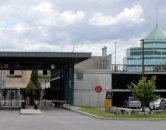Toronto group calls for $15 congestion fee for vehicles entering downtown core

A civic group is advocating for Toronto to adopt congestion pricing, following the route taken by cities such as New York, London, Stockholm and Singapore.
It’s a tactic aimed at reducing traffic in downtowns, with the collected congestion fees meant to go toward improving public transit and urban infrastructure.
The new organization called Build Toronto , launched by national non-profit organization Build Canada , is suggesting a congestion charge of $15 per vehicle to drive in the downtown core.
The congestion pricing suggestion was put forward in a memo, “Keep Toronto Moving With Congestion Pricing” posted to the Build Toronto website and written by Jamie McDonald , CEO of A2X, a firm that provides accounting for sellers on popular online platforms such as Shopify, Amazon, eBay and Etsy.
McDonald contends congestion pricing “works where everything else has failed. Widening highways and removing tolls only make congestion worse … Expanding highways has failed — the 401 is one of the widest in the world and still jams daily.”
The goal, he says, is to reduce downtown commute times by 15–20 per cent within two years, while funding major transit improvements.
Congestion pricing in London has removed tens of thousands of cars a day from its core, he argues. And he notes that in New York, it has taken 43,000 cars a day off Manhattan’s streets (based on preliminary data from its first week of operation).
McDonald proposes the following actions:
- Toronto should introduce a downtown pilot zone.
- On 400-series highways and expressways within and surrounding the city should adopt Singapore’s model of adjusting tolls in real time to maintain average speeds of around 60 km/h.
- Exemptions for emergency vehicles and wheelchair-accessible vehicles should be standard. Targeted discounts for low-income drivers and residents living inside the zone can follow London’s model.
- Revenues should expand GO train frequency, improve Toronto Transit Commission reliability, and build park-and-ride facilities at transit hubs.
This is not the first discussion of congestion pricing for Toronto. In late 2024, the Toronto Region Board of Trade announced a new Congestion Task Force to dig into the problem and come up with “actionable solutions.”
In its December 2024 statement it recognized that establishing congestion pricing is not an easy sell, stating that it’s not a “silver bullet” or “one-size fits all” solution.
For example, it noted New York debated congestion pricing for decades. A plan for Manhattan’s central business district was approved in 2019 but then delayed. Governor Kathy Hochul paused the program in 2024, citing concerns over post-COVID economic recovery. Still, it launched in January .
In Vancouver the city council pushed back against it 2022. The concept had been intensely criticized by businesses worried urban road tolls would discourage patrons. And many citizens worried about the extra cost for drivers who rely on their cars.
Sometimes the debate is nuanced. For example, in London the number of vehicles driving into the city centre dropped by 18 per cent during weekdays as a result of congestion pricing. But earlier this year, a transport analytics company declared London the most congested city in Europe , with drivers spending increasing amounts of time sitting in traffic. Transport for London’s response was that the increased congestion was caused by some car lanes being “repurposed for other uses” such as bike lanes — the subject of recent heated debate in Toronto.
Toronto has had its own tugs of war over congestion pricing. In 2016, a $2 toll on the Gardiner Expressway and Don Valley Parkway was proposed by the city, with an anticipated $200 million boost for transit and infrastructure funding. But the province nixed it, citing affordability concerns. More recently, the Ford government has banned any future tolls on provincial highways and removed them from the 407.
However, the Board of Trade is hopeful that improving public transit, including projects like the Ontario (subway) Line could make congestion pricing more palatable in time.
“As we’ve seen in other global cities, congestion pricing can play a helpful role in alleviating traffic…. (I)t can take years to build consensus and implement and relies on important factors like viable transit alternatives to be successful. Beginning the conversation now can prepare the region for if and when a model could work here in the future.”
Our website is the place for the latest breaking news, exclusive scoops, longreads and provocative commentary. Please bookmark nationalpost.com and sign up for our daily newsletter, Posted, here.




Comments
Be the first to comment